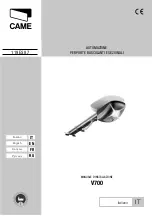
8
• IP 23 protection class and dust-proof
electronic components, thanks to the
innovative
"Tunnel"
fan cooling sys-
tem, allow their use in the toughest
work environments
• The generator also conforms to all
European Union standards and direc-
tives in force
Technical data
The general technical data of the system
are summarized in table 1.
Usage limits
(ISO/IEC 60974-1)
The use of a welder is typically discon-
tinuous, in that it is made up of effective
work periods (welding) and rest periods
(for the positioning of parts, the replace-
ment of wire and underflushing opera-
tions etc. This welder is dimensioned to
supply a I
2
max nominal current in com-
plete safety for a period of work of 25%
of the total usage time. The regulations
in force establish the total usage time to
be 10 minutes. The work cycle is consid-
ered to be 25% of this period of time. If
the permitted work cycle time is
exceeded, an overheat cut-off occurs to
protect the components around the
welder from dangerous overheating.
Intervention of the overheat cut-off is
indicated by the lighting up of yellow
thermostat signal light. After several
minutes the overheat cut-off rearms
automatically (and the yellow signal light
turns itself off) and the welder is ready
for use again. This generator is con-
structed in compliance with the IP 23
protection level.
Safety standards
GENERAL SAFETY STANDARDS
These products must be
used for welding and not
for other improper uses.
Their use is permitted
only by trained and expe-
rienced persons. The
operator must observe the CEI 26.9 HD
407 safety standards in order to guaran-
tee his safety and that of third parties.
ELECTRICAL SHOCK PREVENTION
• Do not carry out repairs
with the generator live.
• Before carrying out any
maintenance or repair
activities, disconnect
the machine from the
mains.
• Ensure that the welder is suitably
earthed.
• The equipment must be installed by
qualified personnel. All connections
must comply with the regulations in
force (IEC 60821) and with the acci-
dent prevention laws.
• Do not weld in damp or wet surround-
ings or under rain.
• Do not weld with worn or loose wires.
Inspect all cables frequently and
ensure that there are no insulation
defects, uncovered wires or loose
connections.
• Do not weld with cables of insufficient
diameter and stop soldering if the
cables overheat, so as to avoid rapid
deterioration of the insulation.
• Never directly touch live parts. After
use, carefully replace the torch or the
electrode holding grippers, avoiding
contact with the parts connected to
earth.
SAFETY REGARDING WELDING
FUMES AND GAS
• Carry out purification of
the work area, from gas
and fumes emitted dur-
ing the welding, espe-
cially when welding is
carried out in an
enclosed space.
• Place the welding system in a well
aired place.
• Remove any traces of varnish that
cover the parts to be welded, in order
to avoid toxic gases being released.
Always air the work area.
• Do not weld in places where gas leaks
are suspected or close to internal
combustion engines.
• Keep the welding equipment away
from baths for the removal of grease
where vapours of trichloroethylene or
other chlorine containing hydrocar-
bons are used as solvents, as the
welding arc and the ultraviolet radia-
tion produced by it react with such
vapours to form phosgene, a highly
toxic gas.
PROTECTION FROM RADIATION,
BURNS AND NOISE
• Never use broken or
defective protection
masks
• Do not look at the weld-
ing arc without a suit-
able protective shield or
helmet
• Protect your eyes with a special
screen fitted with adiactinic glass (pro-
tection grade 9 - 14 EN 169)
• Immediately replace unsuitable adiac-
tinic glass
• Place transparent glass in front of the
adiactinic glass to protect it
• Do not trigger off the welding arc
before you are sure that all nearby
people are equipped with suitable pro-
tection.
• Pay attention that the eyes of nearby
persons are not damaged by the ultra-
violet rays produced by the welding
arc
• Always use protective overalls, splin-
ter-proof glasses and gloves
• Wear protective earphones or ear-
plugs
• Wear leather gloves in order to avoid
burns and abrasions while manipulat-
ing the pieces.
AVOIDANCE OF FLAMES AND
EXPLOSIONS
• Remove all combusti-
bles from the workplace
• Do not weld close to
inflammable materials
or liquids, or in environ-
ments saturated with
explosive gases
• Do not wear clothing impregnated with
oil and grease, as sparks can trigger
off flames
• Do not weld on recipients that have
contained inflammable substances, or
on materials that can generate toxic
and inflammable vapours when
heated.
• Do not weld a recipient without first
determining what it has contained.
Even small traces of an inflammable
gas or liquid can cause an explosion.
• Never use oxygen to degas a con-
tainer.
• Avoid gas-brazing with wide cavities
that have not been properly
degassed.
• Keep a fire extinguisher close to the
workplace
• Never use oxygen in a welding torch;
use only inert gases or mixtures of
these.
RISKS DUE TO ELECTROMAGNETIC
FIELDS
• The magnetic field gen-
erated by the machine
can be dangerous to
people fitted with pace-
makers, hearing aids
and similar equipment.
Such people must consult their doctor
before going near a machine in opera-
tion.
• Do not go near a machine in operation
with watches, magnetic data supports
and timers etc. These articles may
suffer irreparable damage due to the
magnetic field.
• This equipment complies with the pro-
tection requirements set by the 89/336
CEE, 92/31 CEE and 93/68 CEE
directives on electromagnetic compat-
ibility (EMC). In particular, it complies









































